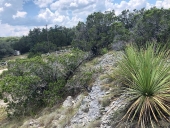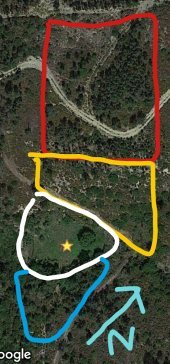
 1
1




















 1
1




"To oppose something is to maintain it" -- Ursula LeGuin
 1
1




















C Snyder wrote:
Area 1: Currently covered in Bermuda grass and dandelion and probably a bunch of other weeds. The area is large enough to be turned into 2 or 3 terraces where it is currently one gradual slope facing west.
1) For Area 1 is it wiser to hand dig a few breaks/paths so as not to disturb the top soil but then have to find a way to get rid of the grass or to mechanically turn everything up and terrace it?
My project thread
Agriculture collects solar energy two-dimensionally; but silviculture collects it three dimensionally.




C Snyder wrote:
3) How can I increase the organic matter for Area 2 quickly so that it is not mostly red clay and will support vegetables and fruit/nut trees? Clover or buckwheat cover crops? Heavy straw cover?
4) When I do terrace Area 2, can I hack up the 6-8' pine trees to be put back in for organic matter or will they have an allelopathic effect on future growth? Should I get rid of those in the interim or do they provide any benefits?
My project thread
Agriculture collects solar energy two-dimensionally; but silviculture collects it three dimensionally.




Blazing trails in disabled homesteading




Matthew Nistico wrote:
I live in your same area and, though I'm just beginning on my own site, I have experienced most of this first hand. Here are some soil building species that I have used or attempted to use: dandelion and wild chicory are always great and will take in any soil conditions; people here have already mentioned comfrey, always a good choice; yarrow is also a good soil buster, and red yarrow (var. rubra) is native to southern Appalachia; rape and/or mustard has strong roots; and then daikon and sweet potato that others here have mentioned. I seeded some daikon in my problem area of hard clay suboil last spring and just left it throughout the season to be killed off over winter. It grew huge! In one spot this spring I have a dead daikon that has hollowed out with rot to the point I could literally put my whole fist and arm inside it and down into the ground! And I always mix in some white Dutch clover seed.









Blazing trails in disabled homesteading




Seed the Mind, Harvest Ideas.
http://farmwhisperer.com









Seed the Mind, Harvest Ideas.
http://farmwhisperer.com




Blazing trails in disabled homesteading












Blazing trails in disabled homesteading

|
They kept fire breathing monkeys as pets! This tiny ad told me so!
Learn Permaculture through a little hard work
https://wheaton-labs.com/bootcamp
|




